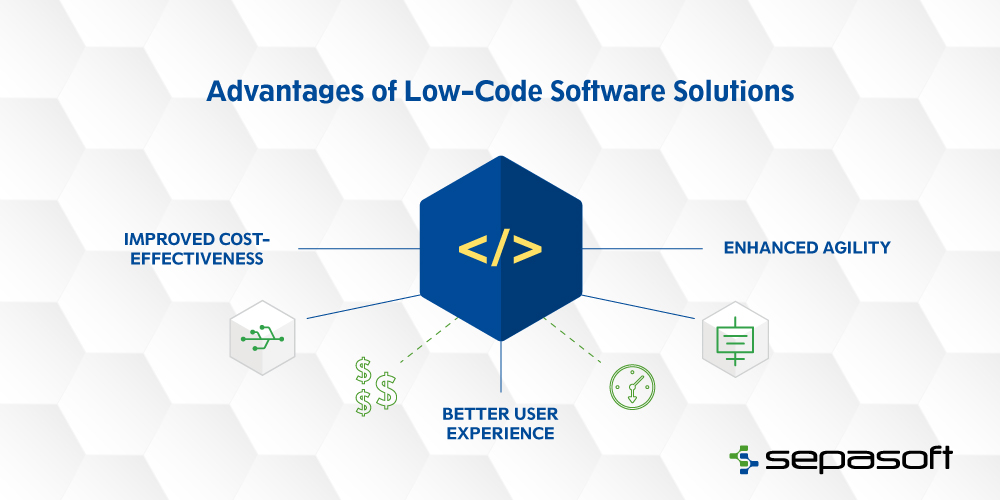Advantages of Low-Code Software Solutions

Advantages of Low-Code Software Solutions
The low-code market is growing at speed, and poised to pick up even more pace over the next few years.
Low-code application platforms are now forecast to make up 65% of all application development by 2024. Gartner, the research firm, anticipates companies will turn to low-code technologies that support application innovation and integration as they increasingly embrace composability, the concept that a business must be built for resilience and accept disruptive change as the norm.
As new solutions are introduced, it’s important to take a step back and define the requirements for what you’re trying to accomplish. In other words, don’t settle for the tool before you understand what you want that tool to do. A manufacturing site demands a different type of low-code solution than other environments.
With that in mind, let’s explore three key benefits that low-code MES software brings:
Improved cost-effectiveness
Less code requires less work from the standpoint of project development, implementation, and maintenance. One of our own initiatives to simplify Track & Trace—our module that gives customers product traceability and real-time inventory management—resulted in a dramatic reduction in the amount of scripting required. In fact, it helped cut the setup time and lines of script by as much as 75%. So, with a low-code, out-of-the box MES option, you get the opportunity to shorten learning curves, cut engineering hours, and—lower costs.
Low-code MES platforms are designed to be accessible to users with varying levels of technical expertise. This democratization of application/project development allows non-technical users to actively participate in creating applications or automating processes. By providing visual tools and abstracting complexity, low-code platforms empower individuals from different departments to contribute to application development, reducing the reliance on a dedicated IT development team. This not only accelerates the development lifecycle but also fosters collaboration between IT and the business. For instance, using scripting to tie a MES system into SAP ERP is not a task just any team member can take on. Our SAP interfacing module has an intuitive mapping tool that lets business and manufacturing personnel understand and connect data between the systems themselves—without the wait and potential for errors that could arise if this activity is pushed off to an IT development team.
Enhanced agility
MES has gained a reputation for being time-consuming to implement. Low-code functionality turns this notion on its head. Manufacturing Digital observes newer MES solutions that incorporate a low-code platform gives users the needed core manufacturing functionality while offering the flexibility to quickly generate purpose-built complementary apps and custom functionality not covered by the core MES.
This means MES can enable manufacturers to respond to cultural changes and quickly adapt to developments in the marketplace. The visual, modular nature of low-code development allows for easy modifications and updates to applications. Organizations can iterate on applications, add new features, and make adjustments without the time-consuming processes associated with traditional coding methods. This agility helps manufacturers stay competitive and responsive to customer demands.
An example is our Graphical Recipe Editor for Batch Procedure which allows recipe authors and operations staff in the food and beverage industry to use drag-and-drop technology to edit recipes. The system’s ease of use requires less training and faster releases of recipe changes to the production floor.
And if you’re rolling out a recipe across a dozen sites and each site is expected to take three months with traditional scripting, you have everything to gain from exploring the low-code route.
Better user experience
Low-code MES solutions replace lines of code with a user-friendly visual interface, including features such as: a graphical interface having visual elements like drag-and-drop components, forms, and widgets; libraries of manufacturing-centric templates (reusable building blocks allowing automatic generation of underlying code); built-in connectors with external systems; tools for automating processes and workflows (like approval processes and decision-making logic); user and role management; and collaboration features. When put into practice, it means you can graphically accomplish those tasks that previously required intensive coding. Scripting should still be available if circumstances demand it, but a visual editor opens up these tasks to more members of your team.
Final word
Low-code software, or software with low-code functionality, is only going to increase in importance over the next few years, across every industry. Whether used to quickly develop consumer apps or scale enterprise platforms, low-code tools lead to dramatic reductions in complexity. In manufacturing, low-code is also making inroads, introducing everything from no-code reporting to batch procedure workflows.
If you would like to learn more on this topic, please view our 2022 ICC session — Sepasoft’s Low-Code Approach to Simplifying MES.
Questions? Contact us today. We always want to hear from you.
